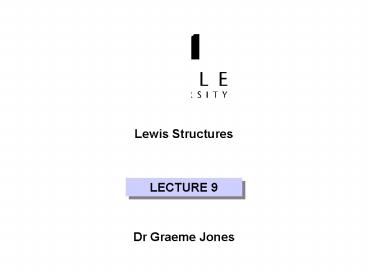che00001che00005che00022 lecture 9 PowerPoint PPT Presentation
1 / 13
Title: che00001che00005che00022 lecture 9
1
Lewis Structures Dr Graeme Jones
LECTURE 9
2
Contents of lecture
- What are Lewis structures?
- General rules for writing Lewis structures
- Examples
- Molecules
- Molecular cations and anions
3
What are Lewis structures?
- Lewis structures are diagrams that show how
electron pairs are shared between atoms in a
molecule. They can explain the bonding in a
molecule but not its shape. - In lecture 8 we saw how to construct the Lewis
structures of some diatomic molecules. When there
are more than two atoms in a molecule, it is
useful to have some rules, which help us to
proceed. Jones and Atkins (4th ed.) pages 333-337
give a useful account of this, from which some of
the examples given in the lecture will be taken.
4
General rules
- Count the valence electrons on each atom, add
them up and find the number of electron pairs. - Decide how the atoms are to be bonded, and use a
pair of electrons for each bond. - Distribute the remaining electron pairs so that
each atom is surrounded by 4 pairs of electrons
(the octet rule).
5
Examples (a)
- NH3
- (i) valence electrons 5 3 x 1 8 gt 4 pairs.
- (ii) 3 pairs are used to link the atoms.
- (iii) 1 pair completes Nitrogens octet (a lone
pair). - HOBr
- (i) valence electrons 1 6 7 14.
- (ii) 2 pairs are used to link the atoms.
- (iii) Distribute the remaining pairs around O and
Br.
6
Examples (b)
- HCN
- Step (i) count the valence electrons on each
atom 1 4 5 10 gt 5 electron pairs. - Step (ii) use 2 pairs to form bonds between the
atoms, leaving 3 pairs. - Step (iii) arrange these in such a way that
both C and N have an octet of electrons (this has
to be achieved using multiple bonds).
7
How to deal with ions
- If ions are charged, the number of electrons
is/are increased or reduced accordingly - H3O
- (i) 3 x 1 6 1 8 gt 4 pairs
- (ii) 3 pairs are used to link the atoms
- (iii) the 4th pair completes the O octet
- NH2-
- (i) 5 2 x 1 1 8 gt 4 pairs
- (ii) 2 pairs link the atoms
- (iii) 2 remaining pairs complete the N octet
8
More complex examples
- The summary sheet mentions HCOOH,
formic/methanoic acid, which is also in Jones and
Atkins (ex. 8.4, p 335). - In examples like HCOOH it helps to know the
structure, at least at the level of which atom is
joined to which, in advance! - However it can be done entirely by following the
rules as there will only ever be one structure
which obeys them in full.
9
HCOOH (i)
- (i) Count the valence electrons
- 2 x 1 4 2 x 6 18 gt 9 pairs
- (ii) Decide on possible ways in which the atoms
could be joined up. - (iii) Put pairs of electrons between the atoms
and ensure that all the atoms have the correct
number of electrons round them.
10
HCOOH (ii)
- Having tried a number of possibilities, we
finally arrive at the correct structure - This structure has the correct number of pairs of
electrons around each atom. - Another example, SO3, will be done (if time
permits)
11
Valency
- Knowing the position of an element in the
periodic table helps you to predict its valency
the number of bonds it requires to make to ensure
a full octet. This is useful to know when
predicting the bonding in organic molecules. - Valency of 1 H, F, Cl, Br
- Valency of 2 O, S
- Valency of 3 N, P
- Valency of 4 C, Si
12
Examples
- Predict the bonding of the following molecules
and draw Lewis structures - CO2 N2H4 H2O2
- CCl4 Cl2CO POBr3
- O3 HNO2 ClO3-
13
Useful websites but there are lots more! (type
Lewis structures into Google)
- (i) http//www.stolaf.edu/depts/chemistry/courses/
toolkits/121/js/lewis/ - This site enables you to choose a molecule or ion
from a drop-down menu and it draws the Lewis
structure for you. - (ii) http//www.ausetute.com.au/lewisstr.html
- A site explaining how to draw the Lewis
structures of atoms and simple molecules. - (iii) http//library.thinkquest.org/3659/structure
s/lewis-drawing.html - A site which explains the general rules with
reference to a SO3 molecule.

